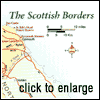|
The East Coast Region
Around Eyemouth
Eyemouth, a harbour community since the twelfth century,
is best reached by leaving the A1 for the A1107. James VI granted the town Freeport
status in 1597 and it immediately became a flourishing centre for smugglers. Some
of the older houses in the maze-like centre have underground passages and hidden
chambers still intact. The cliffs and their numerous caves along the rugged shoreline
were also employed for the storage of booty.
 Activities in the area include golf, walking, fishing and,
surprisingly sub-aqua diving. This is one of the busiest areas on the east coast
for the sport. Eyemouth Golf Club has recently opened an impressive 18-hole course
and clubhouse, skirting the rocky shoreline and overlooking the new harbour development. Activities in the area include golf, walking, fishing and,
surprisingly sub-aqua diving. This is one of the busiest areas on the east coast
for the sport. Eyemouth Golf Club has recently opened an impressive 18-hole course
and clubhouse, skirting the rocky shoreline and overlooking the new harbour development.
At Eyemouth Museum, located near the harbour, the
tale of the Great East Coast Fishing Disaster of 1881 is brought to life in a tapestry.
23 boats were lost in a sudden storm that took the lives of 189 local fishermen.
A few miles north and visible across the bay from
Eyemouth, off the A1 and onto the B6438, is the little village of St Abbs. Overlooking
Coldingham Bay, well known for its colourful pebbles, this village's character is
unique for this part of Scotland. The tranquil port, once renowned for its thriving
haddock and cod industry, resembles a Cornish fishing community, with cottages clinging
like limpets to the steep, rocky shore.
St Abbs Head is just north of the village and best
reached by parking from the main car park and visitors centre between St Abbs and
Coldinham and following the short path towards the cliffs. It is also possible to
drive the single-track road past Northfield Steading Farm and Mire Loch, a dammed
stretch of water and regular stopping place for small birds at migration time. There
is limited car parking just before the entrance to the lighthouse. This dramatic
piece of saw-toothed headland is where the Lammermuir Hills plunge into the North
Sea. There are 192 acres (77 hectares) of protected land edged with craggy, volcanic
basalt that drops 300ft (91m) to ragged rocks below.
Run by the National Trust for Scotland along with
Scottish Wildlife Trust, it is a reserve mainly for sea birds such as kittiwake,
shag, guillemot, fulmar and razor bills. These can be closely observed from the road
or cliff edges although care must be taken as no barriers have been erected. St Abbs
Lighthouse can only be visited with permission from the keeper.
 For those that are sure-footed and interested in visiting
one of the most dramatic sites for a Scottish castle, take the path northwest from
St Abbs Head for about 4 miles (6km) to the impossibly positioned Fast Castle. For those that are sure-footed and interested in visiting
one of the most dramatic sites for a Scottish castle, take the path northwest from
St Abbs Head for about 4 miles (6km) to the impossibly positioned Fast Castle.
This ruined fortress, now only a few stacks of weather-worn
stone perched on a narrow peninsula, was employed by ship-wreckers; some say they
built it and set lights upon it specifically to lure ships onto the rocks. Sir Walter
Scott was so inspired by this ragged promontory and its fort that he employed them
in his novel Lammermoor.
Crossing the busy A1 again a few miles southwest of
St Abbs and Eyemouth is the village of Ayton and Ayton Castle, a distinguished red
sandstone building of the Victorian era. This is still a family home but open during
the season though only on Sunday afternoons or by appointment. It was built in 1846
by an owner who insisted on changing the design as the inspiration took him and the
end result, though assorted, is basically Scottish Baronial with a touch of Gothic.
Manderston and Duns
A few miles south, just off the A6105, is one of the
finest Edwardian houses in Scotland. Manderston is described as the 'swan song of
the great, classical house'. The Miller family, who made a fortune trading with Russia
in herring and hemp, spent a large part of their wealth in turning their home into
this opulent palace. Robert Adam influences the architecture to some extent and it
has one unique feature that few other houses can boast. The silver staircase was
modelled on that found in the Petit Trianon at Versailles. Outside there are 56 acres
(22 hectares) of rhododendrons and azaleas, well worth experiencing in late spring.
The nearby village of Duns is a typical little Borders
town. Like so many neighbouring communities, it was completely destroyed by the English
in 1545 as part of the Rough Wooing, Henry VIII's indelicate attempts to encourage
Mary, Queen of Scots to marry his son. It is now a residential hamlet with a nature
reserve and a newly extended 18-hole golf course. At 44 Newton Street on the west
side of the village, you will find the Jim Clark Memorial Trophy Room, in which the
trophies, letters and memorabilia of this Berwickshire farmer made-good, have been
collected, following his fatal racing accident in 1968.
Coldstream
Coldstream has been a crossing place between England
and Scotland for centuries with a narrow section of the River Tweed offering a ford,
then later, a good bridging point. Apart from the military significance of this crossing,
Coldstream once rivalled Gretna Green for run-away English couples who took advantage
of Scotland's easier marriage laws of the time.
 The quaint town is also closely associated with the famous
military regiment, the Coldstream Guards, and their history is presented in the local
museum. The Hirsel estate, just west of Coldstream, houses the Homestead Museum and
Craft Centre, an old farmstead building offering a rare glimpse into the common tools
and crafts formerly used in this area. The house is closed to the public, although
there is a particularly fine 18-hole golf course on the estate. The quaint town is also closely associated with the famous
military regiment, the Coldstream Guards, and their history is presented in the local
museum. The Hirsel estate, just west of Coldstream, houses the Homestead Museum and
Craft Centre, an old farmstead building offering a rare glimpse into the common tools
and crafts formerly used in this area. The house is closed to the public, although
there is a particularly fine 18-hole golf course on the estate.
A main event in Coldstream's Civic Week in August
is the ride to Flodden Field to honour the dead in that battle of 1513. Flodden is
about 6 miles (10km) across the border, due south of Coldstream and just off the
A697. Here, James IV of Scotland, much against the advice of his lords, lead a gallant
army of men to one of the worst defeats experienced by the Scots in their centuries-long
attempt to secure independence.
|



